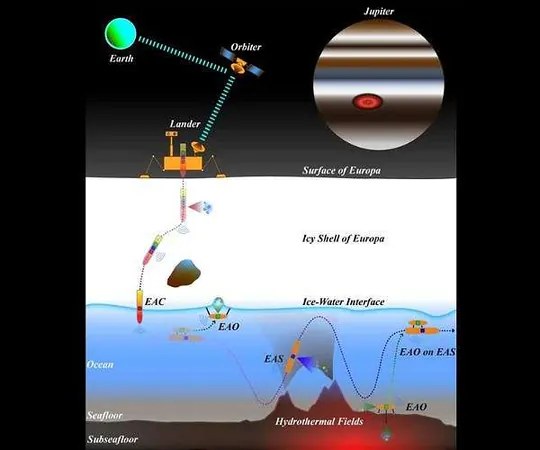
Unveiling Life on Icy Worlds: The Revolutionary Exo-AUV Approach!
2025-01-05
Author: Nur
Exploring the Mysteries of Europa and Enceladus!
Recent studies have spotlighted icy moons like Europa and Enceladus as prime candidates in the search for extraterrestrial life. Beneath their frozen surfaces lie fascinating environments where potential biosignatures—indicators of life—may be found. Scientists are turning to advanced technology, particularly Extraterrestrial Autonomous Underwater Vehicles (Exo-AUVs), to unlock these icy realms and further our quest for understanding life beyond Earth.
Why Icy Moons Matter in the Search for Extraterrestrial Life
These moons harbor vast oceans beneath thick ice shells, presenting unique habitats that could support life. Researchers propose focusing on the ice-water interface, the seafloor, and the subglacial environments, which are considered hotspots for finding both current and prebiotic life forms. Rather than relying on traditional binary analysis which often oversimplifies complex ecological systems, scientists are adopting a more nuanced strategy that recognizes the subtleties of life in these environments.
The Four-Step Autonomous Strategy for Life Detection
An innovative approach to life detection has been proposed, consisting of four essential steps: assuming, sampling, analyzing, and verifying. This method, guided by ecological niche theories, equips the Exo-AUVs to target areas of high biological potential. By collecting a diverse array of biosignatures, these automated explorers could provide insights into whether life exists beneath Europa's icy crust.
Overcoming Extreme Conditions on Europa
Navigating the harsh conditions of Europa requires sophisticated technology. Current missions utilize ice-penetrating carriers powered by innovative energy systems such as Small Modular Reactors (SMRs) or Radioisotope Thermal Generators (RTGs). By leveraging these advancements, the carriers can deploy Exo-AUVs capable of journeying through deep oceanic environments, all while using cutting-edge tools including acoustic sensors, spectrometers, and electrochemical detectors to gather critical data.
The Importance of Autonomy in Exo-AUV Missions
Given Europa’s great distance from Earth, communication delays can be as significant as 30 minutes. This makes high levels of autonomy in Exo-AUV operations indispensable. These vehicles can then process and analyze data on-site while updating their navigation based on the biological potential of their surroundings. Such capabilities usher in a new era for planetary exploration, allowing for rapid and efficient scientific inquiry.
Introducing the Multi-Exo-AUV System (MEAS)
One standout innovation is the Multi-Exo-AUV System (MEAS), a sophisticated network of ice-penetrating carriers and specialized Exo-AUVs. This distributed system is designed to enhance operational capability across Europa's varied environments. With survey modules for large-scale exploration and observation modules focused on detailed analysis, MEAS promises to boost efficiency and adaptability in mission scenarios.
Charting a Path for Future Missions
The development of Exo-AUVs in North America and Europe brings to light significant challenges facing life detection strategies on these icy worlds. As scientists refine their designs, a conceptual roadmap has emerged that highlights the need for integrated technology evolution tailored to Europa's specific conditions. This roadmap aspires to enhance detection strategies, foster operational autonomy, and ensure that future missions are scalable and efficient.
Join the Quest for Life Beyond Earth!
The MEAS strategy not only enhances the search for life on Europa but also lays the groundwork for forming a comprehensive detection network across the moon's global ice and ocean system. With innovative solutions paving the way, researchers are edging closer to potentially uncovering the secrets of these icy worlds. Will we find evidence of life lurking beneath the surface? Only time—and technology—will tell!


 Brasil (PT)
Brasil (PT)
 Canada (EN)
Canada (EN)
 Chile (ES)
Chile (ES)
 Česko (CS)
Česko (CS)
 대한민국 (KO)
대한민국 (KO)
 España (ES)
España (ES)
 France (FR)
France (FR)
 Hong Kong (EN)
Hong Kong (EN)
 Italia (IT)
Italia (IT)
 日本 (JA)
日本 (JA)
 Magyarország (HU)
Magyarország (HU)
 Norge (NO)
Norge (NO)
 Polska (PL)
Polska (PL)
 Schweiz (DE)
Schweiz (DE)
 Singapore (EN)
Singapore (EN)
 Sverige (SV)
Sverige (SV)
 Suomi (FI)
Suomi (FI)
 Türkiye (TR)
Türkiye (TR)
 الإمارات العربية المتحدة (AR)
الإمارات العربية المتحدة (AR)